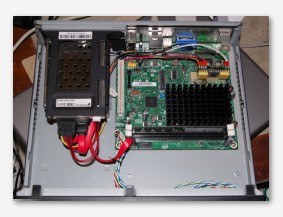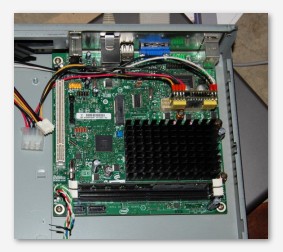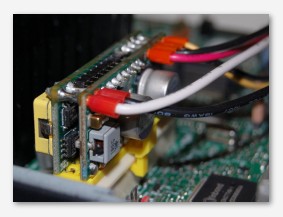My Quest for a Quiet Computer - Revisited
2011-02-27
Some years ago I wrote about my Quest for a Quiet Computer – in which I bought a fanless VIA EPIAmotherboard and a nice mini case (Morex Cubid 2677). It was a tight squeeze, but it all fit and it gave a good few years’ service as an email-reading terminal. Unfortunately, the 500MHz VIA Eden processor was a bit on the slow side, as was the Trident CyberBlade i1 graphics chip. The machine didn’t have a prayer of playing a DVD (For comparison, my old Pentium III laptop of the same clock speed could manage that with no trouble providing nothing else was going on in the background.)
Since then I’ve been keeping one eye on the Mini-ITX market, and was intrigued by Intel’s Little Falls boards, which coupled a netbook-style Atom processor with a regular Desktop G31 chipset. The downside of those boards was the power-hungry chipset, which ate way more power than the processor it was supposed to be supporting. The newer Pine Trail boards, though, including the D510MO which I’ve just bought, couples the new low-power NM10 chipset with an Atom processor which is not only 64-bit capable, but also dual core, while using little enough power that passive cooling is sufficient!
The board itself has pretty much everything you’d expect to find on a regular motherboard, such as front USB connectors, front panel audio connectors, SATA ports (sadly only two of those – it would make a fantastic NAS box if it had more), and while RS232 serial and IEEE-1284 parallel ports are not present on the backplane, there are headers to which you can attach both types of port. The most glaring omission is the lack of a legacy IDE port. This is a shame, because a board like this is an ideal candidate for a Compact-Flash-to-IDE converter.
More unusually, there’s a Mini PCI Express port on the board which would typically take a wireless card (though the heroes at Startech will shortly be selling a SATA controller card in this form factor. Note that the mere wiring adapters found on Ebay as Mini PCI Express to SATA converters are only usable with machines like the Asus EEE PC which uses a socket of this type but with custom wiring, and which does actually bring SATA signals to some of the pins. Most Mini PCI Express sockets don’t do this, so you need an actual controller card.)
Startech Expansion Slot SATA Bay
Speaking of Startech, I previously reviewed their SATA hot-swap bay, and for this project bought another of their gizmos. The previous hot-swap bay took a bare 3.5 inch hard drive. There’s another model available which fits a 3.5 inch bay and has a pair of doors for 2.5 inch laptop hard-drives, but mini-ITX cases with 3.5 inch front-accessible bays are few and far between. The hot-swap bay I’ve just bought, on the other hand, fits in an expansion bay instead! The eject mechanism on this bay isn’t quite as easy to use as the one on the bay I previously reviewed – you have to find a button with your fingernail and push it to one side, at which point a spring pushes the door open - but it works well enough in practice. The bay is supplied with a label that you’re supposed to apply to the underside of the hard-drive, to make absolutely sure it can’t short onto the perforated metal base of the bay. Having examined the drive I planned to use, and made sure the mounting screw holes were proud of the circuit board, I decided to take a chance and not bother with this – I’ve got away with it so far! In use the bay does exactly what’s asked of it – if I have one complaint it’s that there’s a blue power LED on the back, which drowns out the red activity LED that’s also there. Can we please, as a species, get over the whole blue LED thing now? The LEDs are powered by way of an adapter that comes with the bay, which takes both SATA power and LED power from a molex connector.
I specifically decided to use a 2.5 inch drive for this machine, because they use less power and run cooler than desktop drives, and as before I was keen to go with a completely fanless build. Performance isn’t quite as good – but if that was my driving concern I wouldn’t be using a board with an Atom processor! Ultimately I may even set the machine to boot from USB (or even SD-card in a USB adapter plugged onto one of the motherboard headers), and make use of the hot-swapping capability. Or there’s room in the case to mount a fixed drive too.
 That’s the other surprise with this build: I decided to use the same case as my earlier EPIA box, and while the case was previously crammed, there’s now loads of empty space! This is partly because I didn’t bother with an optical drive this time, but the power supply is also a big part of the reason.
That’s the other surprise with this build: I decided to use the same case as my earlier EPIA box, and while the case was previously crammed, there’s now loads of empty space! This is partly because I didn’t bother with an optical drive this time, but the power supply is also a big part of the reason.
The power supply header on the D510MO is in a completely different position from the old EPIA, and I didn’t fancy trying to tame a boa-constrictor-like ATX power extension cable, so I replaced the original DC-DC board in the case with a PicoPSU. This is an incredibly elegant little device comprising a pair of tiny circuit boards soldered directly onto an ATX connector, which plugs straight into the motherboard. On the 120W model I bought (way over-specified for now, but I wanted headroom for more drives in future), there’s one molex, one floppy-power and one SATA power connector coming from the PSU, and one cable which goes off to a chassis-mountable power socket, to which an external 12v power supply connects.
The only difficulty I had installing the board in the old Morex case was that because the audio ports are vertically stacked they slightly foul the expansion slot. With a little bit of filing on the backplane and a little “gentle persuasion” I was able to make it fit, however.
So how does the machine perform? Well, I have to say I’m impressed. I installed Ubuntu 10.10 from a USB stick, and it boots into a perfectly respectable desktop in very little time. The onboard Intel graphics are powerful enough to run Compiz with full eye-candy, and copes admirable with things like desktop zoom. The machine is as near silent as makes no difference – the PicoPSU doesn’t “sing” in the way the previous DC-DC board did, and the 2.5 hard drive is as near silent as makes no different. In fact, the power supply inside the old CRT monitor I’ve been using for testing makes more noise.
In my review of the EPIA way back when, my closing paragraph said “you're not going to be playing RtCW (or even TuxRacer) on one of these any time soon”. I’m pleased to report that Return to Castle Wolfenstein is perfectly playable on the D510MO! (Both natively and under WINE – bizarrely it’s easier to get it working under Wine on a modern installation!) Furthermore, even with no forced-air cooling, and just relying on convection to move air through the case, the heatsink remains relatively cool – perfectly comfortable to the touch, cooler than the old EPIA’s heatsink used to get, and cooler than the PicoPSU!
As I said, I’m impressed with the D510MO – it’s a very capable little machine, and a very reasonable price for what it is - £47 + VAT for a board and processor would be good value for a full-size board, without the premium you’d expect to pay for the small form factor. I do wonder exactly who it’s aimed at, though. The processor and chipset don’t have a prayer of playing 1080p high def video, so this board isn’t going to cut it in the HTPC market. The onboard graphics are OK, but not great – it’ll run Quake 3 era games reasonably well, but it’ll struggle with anything more demanding, so all the but most casual of gamers will be disappointed. There aren’t enough SATA ports to make a decent NAS box, and even higher-end home servers would have been able to benefit from RAID, given more SATA ports. So the markets we have left are casual users who want a small, lightweight machine for checking emails and web-surfing – the “nettop” market, and then people like me who just want something to tinker with. With the D510MO I have a machine frugal enough that I don’t mind leaving it on if I want to use remote access, quiet enough that it won’t disturb anyone if left on overnight, flexible enough that I can swap out the hard-drive in seconds if I want to switch to a different OS. Or if I decide to boot from a fixed drive, I can treat the hard-drives like data cartridges for backup purposes.
There’s also a more powerful board available, the D525MW. This has a slightly more powerful processor, has one RS232 serial and one IEEE-1284 parallel port built in, and instead of full-size DDR2 DIMM slots, has two DDR3 SO-DIMM slots. At the time of writing, DDR3 SO-DIMMs are actually cheaper – at least from the supplier I usually use. Unfortunately the D525MW still only has two SATA ports, so it’s still not an ideal choice for building a NAS box.





